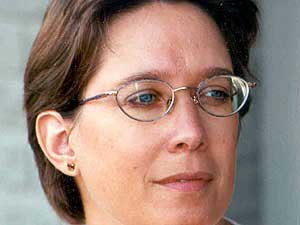Undue corporate influence?
February 17, 2003
 |
| Attorney Cheryl Bergian contends human exposure is routinely overlooked by the Ag Department. "I've come to believe that ... the perspective of the department is to serve the growers. So they don't have the institutional will to determine there have been violations of the law unless they are incredibly egregious violations." (Photo courtesy of Cheryl Bergian) |
Moorhead, Minn. — Cheryl Bergian contends human pesticide exposure is routinely overlooked by the Ag Department. Bergian worked as a legal services attorney for nine years. She handled numerous cases of alleged pesticide exposure to farm workers. She says in nine years, the Ag Department never substantiated a case of human exposure she brought to them.
"If you have a state lab and that's their responsibility and role, you just keep saying, 'How come you can't ever find this stuff?'" says Bergian.
"I've come to believe that the political power is with growers. And that the perspective of the department is to serve the growers," says Bergian. "So they don't have the institutional will to determine there have been violations of the law unless they are incredibly egregious violations."
 | |||
Bergian says she complained to Ag Department officials. In the summer of 2000, Investigation Supervisor John Peckham met with Bergian in Fargo. Another attorney and an Ag Department field inspector were also present.
Bergian says in response to her questions about the Ag Department lab, Peckham told an anecdote.
"He said he was driving in southern Minnesota when his car was sprayed by an airplane. The spray had landed on the front and back windows of his car. He was on his way to meet one of his investigators," says Bergian. "He went immediately there. He and the investigator collected the evidence in the way they are taught to collect exposure evidence and they sent it in to their own lab. And their own lab their own lab couldn't find the pesticide that his own car had been sprayed with."
Bergian thought the anecdote was intended to confirm her questions about the Ag Department lab. John Peckham recalls it differently. He says his intent was to show things are not always as they appear. He says sometimes pesticide residue is so insignificant it won't show up on tests.
Other cases also raise questions about the Minnesota Department of Agriculture lab. Several Minnesota beekeepers are involved in a lawsuit over alleged chemical spray they say, killed their bees. Central Minnesota beekeepers collected dead bees from a single hive. Half were sent to the state Ag Department, the other half to a private lab.
The Department of Agriculture lab did not detect any residue from the pesticide Carbaryl in the dead bees. The private lab found Carbaryl residue. Beekeeper Steve Ellis sees two possible explanations.
|
Either there's a degree of incompetence that needs to be looked at in the state lab, or if you want to carry it a step farther -- they're trying not to find anything and doing a very good job of it.
- Beekeeper Steve Ellis, whose hives were sprayed |
"Either there's a degree of incompetence that needs to be looked at in the state lab, or if you want to carry it a step farther -- they're trying not to find anything and doing a very good job of it," says Ellis.
The Ag Department could not explain the discrepancy between its test and the test done by the private lab. They said perhaps the sample had not been properly collected. But in a sworn deposition, a department lab supervisor admitted lab tests may have been flawed. He noted the Ag Department lab had little experience testing bees for the pesticide in question.
The Ag Department is the only state agency with the authority to investigate pesticide misuse. Those investigations rely heavily on the Ag Department lab to test for pesticide residue. Ag Department Investigations and Enforcement Manager Paul Liemandt, says cases of human exposure are given top priority and aggressively investigated. And Liemandt says he has complete confidence in the Ag Department lab.
"Our laboratory has the capability to probably find and identify and quantify more active ingredients of various pesticides than any laboratory in Minnesota," says Liemandt.
But Liemandt appears to contradict that statement in written documents. He chairs a national organization of pesticide regulatory officials known as SFIREG, the State FIFRA Issues Research and Evaluation Group. FIFRA refers to federal pesticide law, which is generally enforced by states.
In 1999, Liemandt co-authored an issue paper for SFIREG. The document said state labs did not have adequate equipment and know-how to adequately enforce pesticide laws. The report continued:
|
Our laboratory has the capability to probably find and identify and quantify more active ingredients of various pesticides than any laboratory in Minnesota.
- Paul Liemandt, Agriculture Department |
"The lack of analytical capability severely limits the effectiveness of state regulatory, enforcement and environmental monitoring programs as set forth in the EPA/states cooperative agreement. The inability to analyze for these compounds opens the EPA, SLAs (state lead agencies) and state laboratories to criticism from opponents of pesticide use, who may rightly assert that the responsible agencies either do not know how to adequately monitor pesticides in the environment, or that they are unwilling to do so."
The concerns raised in that 1999 report were reinforced in 2000, and again just two months ago, in December 2002, at a SFIREG meeting in Arlington, Virginia.
A report from that meeting says:
"As co-regulators with the EPA, we asked that the EPA acknowlege and thereafter financially support the fact that many new active ingredients challenge the current capabilities of SLA labs. Without this support, future monitoring and misuse actions are seriously in peril and may not be achievable with current technologies."
Paul Liemandt admits he still has concerns about lab technology.
"Some of those unique and new chemistries challenge our current laboratory capabilities -- both the equipment available and the ability of analysts," says Liemandt.
The Minnesota Department of Ag pesticide lab does not have to be accredited by any scientific organization. That means the lab doesn't have to prove to anyone that its testing methods are accurate.
By contrast, state law requires all labs doing work for state agencies to be accredited. Ag Department officials say the lab follows a strict program of quality control to ensure it's results are accurate.
A chemical analysis expert says lab accreditation is an important safeguard. Jerry Parr, executive director of the Institute for National Environmental Laboratory Accreditation, compares accreditation to a driver's license.
"You have to prove you know what you're doing," says Parr.
Pesticide residue testing is a challenging science, by all accounts. When a new pesticide is registered, the company must provide a scientific method for finding residue.
Say there's a new pesticide for use on corn. The testing method would be designed to find residue on corn plants. Experts say very different methods are needed to find the pesticide on clothing. Often, new methods must be developed for each case the lab investigates.
Parr says it's important to remember pesticide testing is not a perfect science.
"It's a messy science and very unpredictable," says Parr. But Parr says with proper equipment, training and procedures, pesticide monitoring can be quite accurate.
The Minnesota Department of Agriculture says it follows an EPA quality control/quality assurance plan. That means it must have a plan for providing quality control, but doesn't need to prove its testing methods to any outside entity.
Minnesota Department of Agriculture pesticide regulation and enforcement is funded almost entirely by fees generated by licensing and registration of pesticides. Those fees have not been increased in at least 10 years.
Paul Liemandt acknowledges monitoring and enforcement efforts could be improved if pesticide fees generated more money. He's unsure if the Ag Department has any plans to ask the Legislature to increase those fees.
|
News Headlines
|
Related Subjects
|

